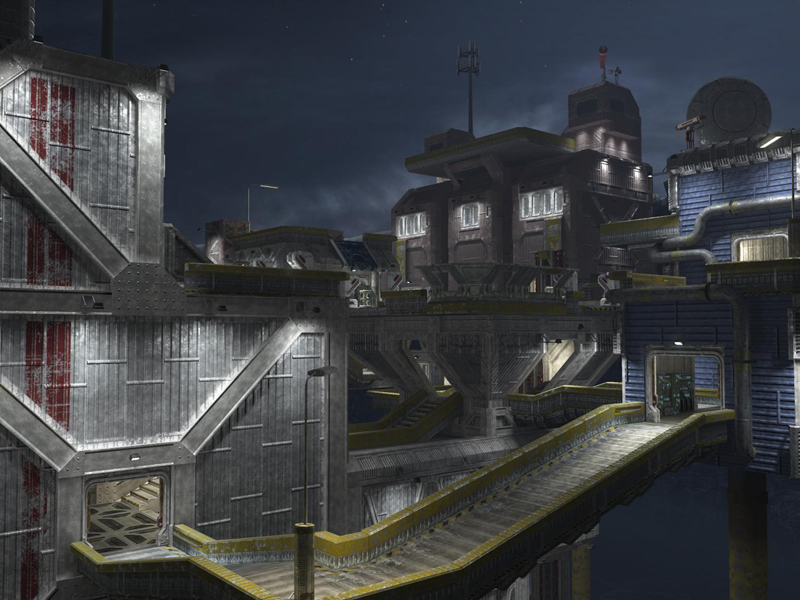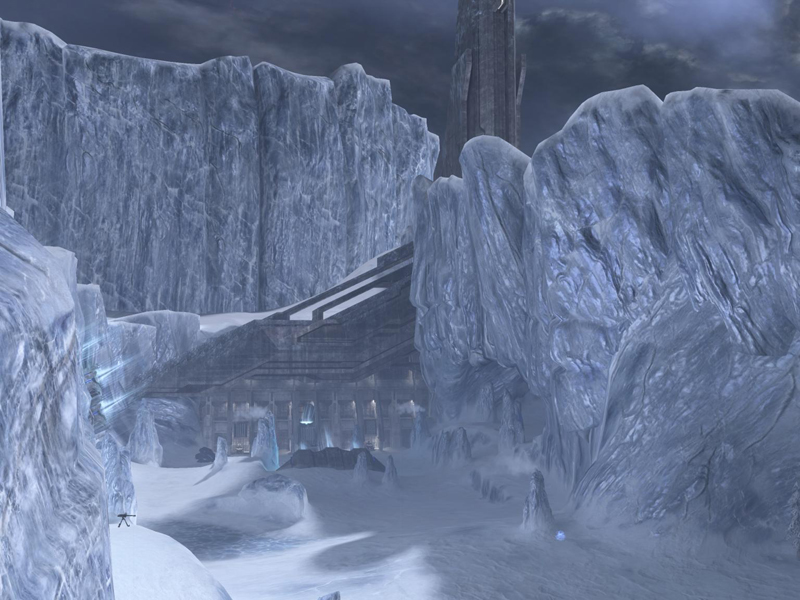Halo 3 Legendary Map Pack: A Scientific Approach
BY Michael Ubaldi // April 24, 2008
Applying reason to anthemic space opera.
aving once before applied reason and the scientific method to martial, anthemic space opera, Michael returned to the laboratory for a systematic, dispassionate review of Halo 3's second edition of downloadable content, the Legendary Map Pack. The results of his study follow.
Summary: A remote UNSC weather station that evokes powerful déjà vu.
Observations: From an odd angle on a metal platform, only heavy machinery can be seen, the oscillating hum of fusion cores heard. Five steps forward, and the unmistakable outline of Lockout is visible from atop the structure serving as Blue Base.
Dimensions appear to be closer approximations to the original map's than Last Resort's were to its predecessor, Zanzibar. But rebuilding the station as human, not Forerunner, construction was clearly an opportunity to clarify every gameplay element as a practical utility. The sniper roost is now a radio tower, the Magnum chamber is now the ad hoc basketball court in a barracks' loading bay, the elevator is now a fan-driven vent, and the flag's location is now denoted by a lone lamppost (see Fig. 1).
From that lamppost, a turn upward reveals a full moon and charming details of operation — a wind sock, an automated weather system antenna, a communications array and some swinging lights on the barracks' second floor. This conventional but authentic setting not only dresses a four-year-old map but establishes a narrative that was, for Lockout, merely incidental.
Light and shadow, contrasted to the point of chiaroscuro, is applied to familiar points across the map (see Fig. 2). It respectively exposes or veils, increasing and decreasing the tactical value of locations, and potentially reordering the balance of a match.
Hypothesis: Halo 2's best close-quarters map should be well-received, possibly edging out release-date contemporaries Construct and Epitaph.
Matchmaking Experiment: A Slayer match confirmed this map's similarity to Lockout; perhaps more than one might expect. Opposing teams' tactics were recognizable from the start, thus was the match's pacing — a struggle for power-weapons, securing of positions, then a slow creep toward 50 kills. Lighting changes did not have any noticeable effect on play.
Preliminary Conclusion: With few distinctions between it and Lockout, Blackout will please those eager for the same experience.
Summary: A Forerunner installation built into one hell of an upthrown fault-block.
Observations: A frozen, tunneled rock face and glossy stalagmites draw the eye first. A bulky man-cannon, standing immediately behind, is one of several — the least discreet of Forerunner architecture intersecting with nature (see Fig. 3). Two functionally identical bases sit parallel against the mountain, separated by the rock-faced uplift and joined by a long, snowy, U-shaped course.
The bases' interiors are superficial: only large enough to fit a flag or a bomb target, and a few defenders. Stylings, drawn from Halo 3, are yet reminiscent of Halo: Combat Evolved. Access is possible from the ground floor; a narrow passage; a man-cannon pointed straight at the base; and a teleporter whose entry point is far forward, at the tangent of the snowy course.
Tunnels allow fairly direct, base-to-base movement by foot. Further inside the uplift, two man-cannons act as bridges between a pair of cantilevered ledges, one ledge leading outside to the furthest point of the course. Vehicles of several designs are parked at the base. The map's impression of openness, however, isn't strong — owing to its inspirational map, Sidewinder.
A Mongoose, driven by Subject A, revealed the course to be of a larger size not initially apparent. This investigation ended when the Mongoose fell off the fault-block (see Fig. 4). A second Mongoose, driven by Subject B, was attempting a closer examination of the course when it also fell off the map's precipice.
Hypothesis: Complaints about the small size of Halo 3's maps won't have been answered.
Matchmaking Experiment: The experiment was colored by two matches of a frustrating gametype called Team Duel — a Slayer variant in which stealth, subtlety and personal cloak are rendered worthless by triangular markers identifying all opponents. Far too large for eight players, the map saw a pair of drawn-out, aimless matches. Capture the Flag, however, was a perfect fit. Man-cannons came to frequent use. The U-shaped course was large enough to permit vehicle battles but not so expansive that machinery couldn't be deployed to a flag or other hotspot on short notice. Use of the Hornet proved effective and even intriguing; its power limited, the VTOL functioned as both an anti-personnel unit and a personnel carrier. In one game, a Hornet pilot dove near a teleporter to airlift his flag-bearing teammate.
Preliminary Conclusion: While there is still work to be done for dedicated sixteen-player maps, Avalanche is a finely tuned addition to Sandtrap and Valhalla.
Summary: A decrepit, bombed-out pump station in a lush gully.
Observations: The first sense of things is shared between birdcalls, smashed glass, naked girders and a supple tree. A skylighted building anchors the squarish map; its collapsed basement, punctured walls and remaining door providing half a dozen entry points and escape routes. Outside are the remains of an industrial site configured in a loose grid, encircled by flora-caked valley slopes (see Fig. 5). Only one avenue runs unobstructed, end-to-end across the complex — the rest of the map is cordoned into sections by structures, machinery and debris.
Obstacles, while varied, are each logically placed. Counterclockwise from the first building are concrete outflow pipes, broken to form a disjointed tunnel. Beyond them lies a makeshift courtyard, surrounded by a series of structures whose gaping rents allow easy movement between levels.
Proceeding with a counterclockwise tour, another building — the most complex, or perhaps simply the most intact — rises to three stories. Only two are accessible, the third beyond reach even with the use of a grav-lift.
This map relies on the mechanics of building interiors, whereas the Halo 2 urban map Turf appeared to include a few enclosed spaces as an afterthought. Its area and height are constrained but it has so many dips, rises and blind turns that games of cat-and-mouse between teams would seem inevitable (see Fig. 6).
Hypothesis: With strictly small-arms weapon sets, Ghost Town could provide more dynamic play than Turf.
Matchmaking Experiment: Eight-player Slayer was fast-paced but well-paced. Respawning was noticeably imprecise, separating teams and interrupting coordination. The map's small size, however, made regrouping fairly easy. Clashes seemed mostly to take place along the main drive. A walkway in front of the skylighted building, there on the alley just off the main drive, became a strong point of choice. From there, a talented sniper dominated the balance of the match — and in doing so undermined the map's appeal. So many nooks and crannies were meant for run-and-gun, and yet players avoided them, firing across the map with battle rifles and needlers.
Preliminary Conclusion: Ghost Town's unique terrain may not be fully appreciated without a limit to armament.
© 2008 Game and Player. All rights reserved.





